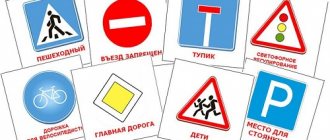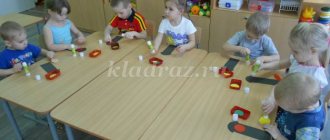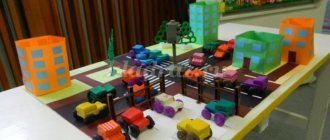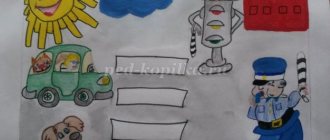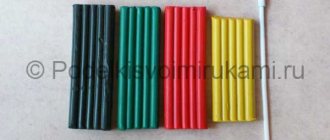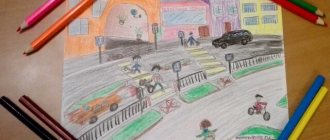Summary of OD on traffic rules in the 2nd junior group “Our friend is the traffic light”
Summary of OD on traffic rules in the 2nd junior group “Our friend is the traffic light”
Abstract
educational activities on the topic “Our friend is the traffic light” with children 3-4 years old
Tasks. Educational:
– introduce children to traffic lights, explain why they are needed; – learn to stick circles on a rectangle, alternating their sequence (red, yellow, green); – explain what each traffic light means; – practice using the correct gluing techniques; – distinguish and name a geometric shape: a circle and three primary colors; – activate the vocabulary: traffic light, green (red, yellow) color, steering wheel, safety, road, transport, sidewalk, roadway, shoulder, pedestrian crossing, intersection).
Educational:
– develop attention, memory, fine motor skills of the fingers, the child’s speech, independence and accuracy in work, and bring what you start to the end.
Educational:
– cultivate a desire to help everyone who needs it and evoke positive emotions from NOD.
Materials for OD:
– demonstration material “The ABCs of Safety”; – a tray with cut circles: red, yellow, green; – traffic light layout; – traffic light rectangle; – steering wheels for the game; bird masks; – glue – pencil, cardboard, wet wipes; – tape recorder, audio recording; - basket, treat.
Vocabulary work
: layout, traffic light, red, yellow, green.
Preliminary work:
A conversation about traffic rules, looking at illustrations, “Road signs” - lotto, outdoor games: “Sparrows and a car.”
OD move:
Educator: Guys, we have guests today. Let's say hello to them. Well done! Now let’s stand in a circle and hold hands. (The audio recording “Smile” plays). Do you feel the warmth that comes from your friends? Imagine how the sun warms you. Now let's smile at each other. How joyful and pleasant, really! (Children sit at tables). Dear guys, the Bunnies called me. They got into trouble. And guess which one for yourself by solving the riddle.
Riddle Who will tell pedestrians what to do along the road? In red: “Stop! “- shouts, Yellow: “Wait...” - says, and the green one lights up, this means to everyone: “Go.” (Traffic light) Do you know what a traffic light is for?
The teacher praises the children. You said it right. Well done. A traffic light is needed for order on the roads, so that people and cars follow the rules of the road.
Teacher (shows the layout of the traffic light): the traffic light has three main colors: red, yellow, green regulate traffic (the red light comes on). Guys, do you think it’s okay to cross the road now? Of course not. The color red lets everyone know - Don’t step on the road! What traffic light is on now? (yellow light comes on). Children. Yellow.
Educator. The yellow color is in the middle, And it has its own picture: Pedestrians are all standing, Waiting, watching as the color of the sun in the traffic light is replaced by green. What traffic light is on now? (green light turns on). Children. Green.
Educator. The green color lets you know - Here it’s your turn guys, We all move forward cheerfully, On the road without yawning, And without pushing each other.
Educator. But the trouble is, guys, the bunnies say that they cannot cross the road because the traffic light on the road is broken. And at home, mother Hare is waiting for them and is very worried about her babies. The bunnies really want to go home. Do you think we can help them? Children: Of course we can.
Educator: How? Children: Make a traffic light applique.
Educator: Well done, guys! Look carefully at the traffic light. What shape is its main part? Children: Rectangular in shape.
Educator: Well done! And there are three main signals on it. Which? Children: Red, yellow and green.
Educator: Correct. What are the shapes of the traffic lights? Children: Round.
Educator: Well done! And you know this very well. Please note: on your tables there are trays with ready-made traffic light parts - these are three multi-colored circles and a rectangle, the traffic light itself, which is not yet working. And for it to work, you need to arrange the circles in the correct sequence. Educator: What color is the first circle? Children: Red.
Educator: Correct. What color is the second circle? Children: Yellow.
Educator: Well done. What color is the third circle? Children: Green.
Educator: That's right. Physical education
And we will play with you.
Everyone leave the tables and stand on the mat. I have three mugs in my hands, these are the eyes of the traffic light. If I show you a red circle, you will have to sit down, if it is yellow, you will have to stand, if it is green, you will have to walk. Educator. We had a rest. Now let's get down to business. You will need to paste traffic light circles onto this rectangle, leaving small distances between them. If you get your pens dirty, we wipe them with wet wipes that are on your tables. Let's remember what you can't do with glue - a pencil? Children. You cannot put glue or a pencil in your mouth .
Educator. Where do we put glue or pencil after work? Children. On a plate.
Educator. Take each circle one by one, grease it with glue and glue it. What did you guys do? Children: Traffic light.
Children. Even though you have no patience - Wait, red light! Yellow light on the way - Get ready to go! Green light ahead - Now cross!
Educator: Well done, guys. You helped the bunnies a lot. And now they won’t be afraid to cross the road. Because you fixed the traffic light. Your traffic lights turned out neat and correct. Thank you very much for your help. Now let’s tidy up our work areas and wipe our hands with wet wipes. Educator. - Guys, what did we do today? (Children's answers). Let's say again what each traffic light means? Children: 1. Red light - stop. 2.Yellow - get ready. 3.Green – go. You are so great today! Oh guys, I see a basket. What's in it? And where did she come from in our group? Can I have a look? There is a letter in it. Do you have any idea who it's from? Can I read the letter? “Dear guys! Thank you very much for your assistance. Now we are not afraid to cross the road. As a token of gratitude, please accept sweet gifts from us. Bunnies."
And I invite you to play the game “Sparrows and the Car.” The child pretending to be a car is given a steering wheel. The rest of the children, playing the role of sparrows, wear hats with pictures of sparrows. The “sparrows” chirp and jump merrily. At the signal “Car!” they run away. The car drives and buzzes: “Beep.”
Integrated lesson on traffic rules in the 2nd junior group. Topic: “Friends of the traffic light”
Transcript
1 Integrated lesson on traffic rules in the 2nd junior group. Topic: “Friends of the traffic light” Objectives: Educational: To consolidate children’s knowledge about the traffic light, its importance in organizing safe traffic on the roads. Reinforce the names of colors (red, yellow, green), give children knowledge about where and how to cross the street, introduce them to special signs - pedestrian crossing indicators, and introduce the word “crossing” into the children’s active vocabulary. Learn to create an image of a traffic light by attaching the finished form one below the other at an equal distance; develop the eye, coordination in the “eye-hand” system; Developmental: develop attention, skills of safe behavior at a pedestrian crossing, teach perseverance and accuracy; activate the vocabulary (traffic light, the color is red, you can’t go, pedestrian, traffic rules, write a short story about the traffic light. Educational: cultivate a culture of behavior on the road, cultivate the desire to be polite, kind and attentive towards each other. Vocabulary work: red, yellow, green, traffic light, pedestrian crossing. Preliminary work: conversations about traffic rules, the rules of safe behavior on the street; looking at illustrations, posters on traffic rules; reading poems and stories about traffic lights. Visual aid: model of a traffic light; sign "Pedestrian transition", subject pictures: "City Streets". Educational areas: Social and communicative development, cognition, speech development, artistic and aesthetic development, physical development. Sections: speech development, familiarization with the environment. Equipment: magnetic board, three circles of different sizes, glue, road layout, doll, toy car, TV, audio recording.
2 Course of the lesson: 1. Game “Who is good with us, who is handsome with us?” The teacher seats the children on chairs. Using the text of a Russian folk song, he says: Who is good with us? Who is our handsomest? The teacher takes him out and hugs him. Vanechka is good (Olechka is good), Vanechka is handsome (Olechka is beautiful). Having praised 4-6 children, the teacher offers them a hug, and then invites all the children to his place and offers them a hug. The teacher takes turns hugging the children who were unable (did not want) to find a partner. “My children are wonderful,” the teacher concludes his conversation with the kids, “beautiful, smart, kind, cheerful. I love you all". Surprise moment: The teacher draws the children’s attention to a beautiful bag. Educator: Guys, look what I found in our group! What it is? Children: bag. Educator: I haven’t seen him here before, I wonder how he ended up here? Somebody knows? Children: no. Educator: It looks like Santa Claus's bag. What do you think lies in it? Children: candy, toys. Teacher: takes the bag in his hands and invites 2-4 children to find out by touch what is in the bag. (Game “Wonderful Bag”) First, 2 cars were pulled out of the bag. There's something else in the bag.
3 Day and night I burn, I give signals to everyone, I have three colors, What is my friends name? (Traffic light.) That's who came to visit us. - This is a traffic light. Tom, repeat what it is. Venya, Ira. Now let’s say it together - traffic light (2 times) Educator: - Where did you see him? Right! A traffic light helps cars drive without colliding, and pedestrians cross the road safely! Let's look at it. Touch it. - What shape are its lights? (Round.) -Where is the red signal located? (At the top of the traffic light). Yellow? (In the middle.) Green? (Below.) - What do the traffic lights mean? (Red stop, yellow wait, and green go!) You must obey the traffic light instructions without arguing. Red, light is a dangerous color. If you have to wait for yellow, you can’t run. The green light says “That’s it, go, the way is open.” — Did you like this poem? Educator: our friend the traffic light will always tell you what to do. Educator. Guys, look at the picture, what is on the road? Slide Children Cars, traffic lights, pedestrian crossing, roadway. Voss. Do you think the pedestrians in the picture follow traffic rules? What about cars? Voss: Let's bring the picture to life. Once upon a time there was a machine. She had wheels sh-sh-sh (children show a circle with their hands) The doors opened and closed s-s-s. The windows were clanking, ding, ding.
4 The headlights blinked (children click-clack tongue) Done, what a beautiful car we have. Showing toys. Physical exercise. Guys, let's show how we drive a car. The teacher shows and says “Red Yellow Green turns on the machine (it beeps) and perform the movements. To the music of Zheleznova “Bus”. There is a knock: the teacher reaches out from behind the screen Masha: Hello, guys! Help me please! Tell me where and how you can walk on the streets, otherwise I don’t know the rules of the road. Educator: Our children do not walk the streets alone, but only with their mothers and fathers. And they play strictly on the playground, and know the rules of behavior on the street and on the road. Masha: What if I need to cross to the other side of the street, what should I do? Ved: You need to look for the Zebra. (Or immediately: show the zebra. Children, show Masha where the zebra is on our road) Masha: Zebra? She lives in hot countries. Ved: Zebra lives in Africa. He drinks water, chews grass, and wants to frolic. And on our street, here at the intersection, it’s like a zebra crossing, just right, a striped transition. Masha: Well, why do I need it? Show a road or slide layout. Ved: - Look, Masha, a zebra is a section of the road along which we pedestrians are allowed to cross the street, it is indicated by wide white lines: a white stripe, a black stripe and again white, black. This is a pedestrian crossing. It is also indicated by a sign. Let's, children, install a pedestrian crossing sign so that everyone can see it. Masha: - Now I understand where the zebra is. You need to cross the road at the zebra crossing.
5 Pedestrian, pedestrian, remember the crossing! Educator Tell Masha who establishes order on the roads, controls the movement of cars? - traffic light (children's story about the traffic light) 1. The traffic light is located by the road, next to the roadway. It has 3 colors: red, yellow and green. 2. The red light is at the top. Red is a dangerous color. When it burns you have to stand. 3. If you have to wait for yellow, you can’t run. 4. The green light says “That’s it - go, the way is open” Masha. Thank you guys, your stories were interesting and understandable. Let's make a traffic light for Masha so that she can tell her friends the rule for crossing the road. Educator. Sit quietly in your chairs and listen carefully. First we will light the red light, it is at the very top. — What light is on at the traffic light in the middle? - What color is the bottom light? Educator. - What great fellows you are! Our traffic light has started working and has turned on its flame! - At what traffic light can we cross the street? Children. When green. Educator. Well done! I think you will never break traffic rules. Summary of the lesson. What great guys you are, kids. What beautiful traffic lights you have made. (say who tried) Masha: Thank you, guys. I really liked your traffic light. I'll show it to all my girlfriends. Goodbye children. Expected result: 1. Know: the importance of traffic lights in organizing safe traffic on the roads
6 2. Be able to: find pedestrian crossing signs on the roads, use them 3. Have: the desire to remember traffic lights and road signs.
